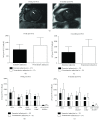Apoptosis and Mobilization of Lymphocytes to Cardiac Tissue Is Associated with Myocardial Infarction in a Reperfused Porcine Model and Infarct Size in Post-PCI Patients
- PMID: 29743973
- PMCID: PMC5878889
- DOI: 10.1155/2018/1975167
Apoptosis and Mobilization of Lymphocytes to Cardiac Tissue Is Associated with Myocardial Infarction in a Reperfused Porcine Model and Infarct Size in Post-PCI Patients
Abstract
ST-segment elevation myocardial infarction (STEMI) is the most severe outcome of coronary artery disease. Despite rapid reperfusion of the artery, acute irrigation of the cardiac tissue is associated with increased inflammation. While innate immune response in STEMI is well described, an in-depth characterization of adaptive immune cell dynamics and their potential role remains elusive. We performed a translational study using a controlled porcine reperfusion model of STEMI and the analysis of lymphocyte subsets in 116 STEMI patients undergoing percutaneous coronary intervention (PCI). In the animal model, a sharp drop in circulating T lymphocytes occurred within the first hours after reperfusion. Notably, increased apoptosis of circulating lymphocytes and infiltration of proinflammatory Th1 lymphocytes in the heart were observed 48 h after reperfusion. Similarly, in STEMI patients, a sharp drop in circulating T lymphocyte subsets occurred within the first 24 h post-PCI. A cardiac magnetic resonance (CMR) evaluation of these patients revealed an inverse association between 24 h circulating T lymphocyte numbers and infarction size at 1-week and 6-month post-PCI. Our translational approach revealed striking changes in the circulating and tissue-infiltrating T lymphocyte repertoire in response to ischemia-reperfusion. These findings may help in developing new diagnostic and therapeutic approaches for coronary diseases.
Figures






Similar articles
-
Remote ischemic post-conditioning of the lower limb during primary percutaneous coronary intervention safely reduces enzymatic infarct size in anterior myocardial infarction: a randomized controlled trial.JACC Cardiovasc Interv. 2013 Oct;6(10):1055-63. doi: 10.1016/j.jcin.2013.05.011. JACC Cardiovasc Interv. 2013. PMID: 24156966 Clinical Trial.
-
Effect of Hematologic Parameters on Microvascular Reperfusion in Patients With ST-Segment Elevation Myocardial Infarction Treated With Primary Percutaneous Coronary Intervention.Angiology. 2016 Feb;67(2):151-6. doi: 10.1177/0003319715583204. Epub 2015 May 25. Angiology. 2016. PMID: 26007233
-
Osteoprotegerin in ST-elevation myocardial infarction: prognostic impact and association with markers of myocardial damage by magnetic resonance imaging.Int J Cardiol. 2013 Sep 1;167(5):2134-9. doi: 10.1016/j.ijcard.2012.05.101. Epub 2012 Jun 15. Int J Cardiol. 2013. PMID: 22704876 Clinical Trial.
-
Emergency percutaneous coronary intervention (PCI) for the care of patients with ST-elevation myocardial infarction (STEMI).Minerva Cardioangiol. 2007 Oct;55(5):593-623. Minerva Cardioangiol. 2007. PMID: 17912165 Review.
-
Radial versus femoral access for primary percutaneous interventions in ST-segment elevation myocardial infarction patients: a meta-analysis of randomized controlled trials.JACC Cardiovasc Interv. 2013 Aug;6(8):814-23. doi: 10.1016/j.jcin.2013.04.010. JACC Cardiovasc Interv. 2013. PMID: 23968700 Review.
Cited by
-
The prognostic value of admission lymphocyte-to-monocyte ratio in critically ill patients with acute myocardial infarction.BMC Cardiovasc Disord. 2022 Jul 7;22(1):308. doi: 10.1186/s12872-022-02745-z. BMC Cardiovasc Disord. 2022. PMID: 35799102 Free PMC article.
-
Higher Platelet-to-Lymphocyte Ratio Is Associated With Worse Outcomes After Intravenous Thrombolysis in Acute Ischaemic Stroke.Front Neurol. 2019 Nov 13;10:1192. doi: 10.3389/fneur.2019.01192. eCollection 2019. Front Neurol. 2019. PMID: 31798520 Free PMC article.
-
The interplay between T lymphocytes and macrophages in myocardial ischemia/reperfusion injury.Mol Cell Biochem. 2024 Aug;479(8):1925-1936. doi: 10.1007/s11010-023-04822-z. Epub 2023 Aug 4. Mol Cell Biochem. 2024. PMID: 37540399 Review.
-
The Predictive Values of White Blood Cell Indices (Lymphocyte and Eosinophilic Granulocyte) for Heart Failure in Acute Coronary Syndrome Patients Following Percutaneous Coronary Intervention: A Prospective Cohort Study.Clin Interv Aging. 2023 Jun 17;18:951-962. doi: 10.2147/CIA.S413313. eCollection 2023. Clin Interv Aging. 2023. PMID: 37351380 Free PMC article.
-
Interleukin-6 inhibition in ST-elevation myocardial infarction: Immune cell profile in the randomised ASSAIL-MI trial.EBioMedicine. 2022 Jun;80:104013. doi: 10.1016/j.ebiom.2022.104013. Epub 2022 Apr 30. EBioMedicine. 2022. PMID: 35504178 Free PMC article.
References
MeSH terms
LinkOut - more resources
Full Text Sources
Other Literature Sources
Medical
Miscellaneous

